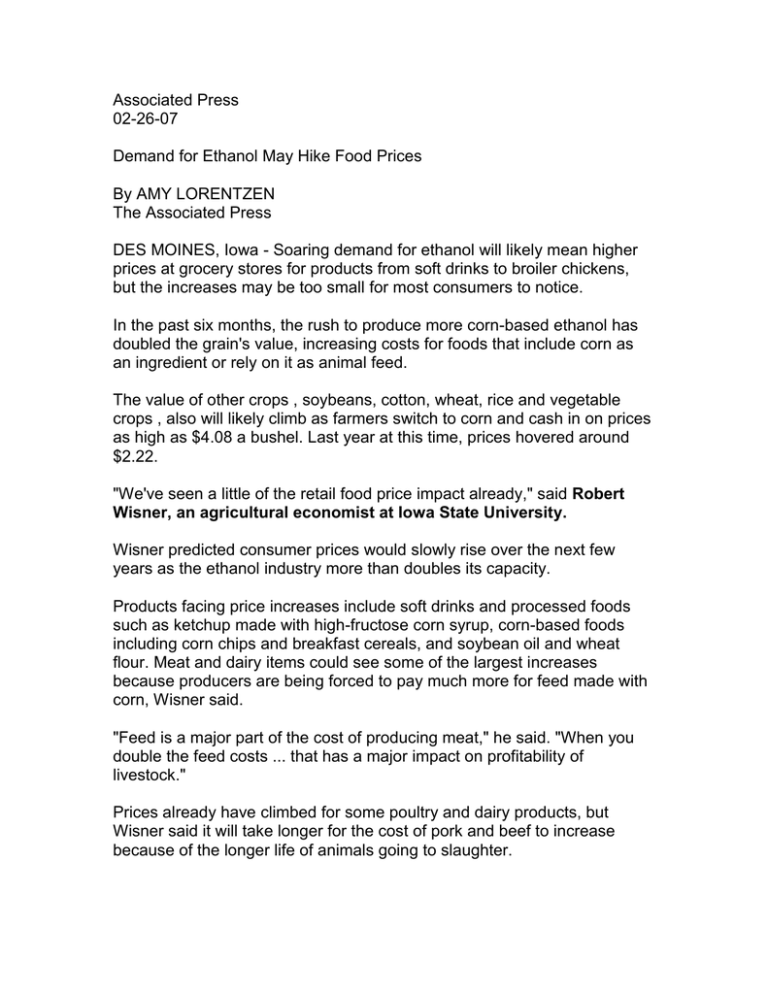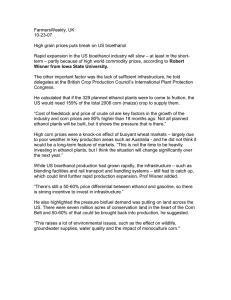Associated Press 02-26-07 Demand for Ethanol May Hike Food Prices
advertisement

Associated Press 02-26-07 Demand for Ethanol May Hike Food Prices By AMY LORENTZEN The Associated Press DES MOINES, Iowa - Soaring demand for ethanol will likely mean higher prices at grocery stores for products from soft drinks to broiler chickens, but the increases may be too small for most consumers to notice. In the past six months, the rush to produce more corn-based ethanol has doubled the grain's value, increasing costs for foods that include corn as an ingredient or rely on it as animal feed. The value of other crops , soybeans, cotton, wheat, rice and vegetable crops , also will likely climb as farmers switch to corn and cash in on prices as high as $4.08 a bushel. Last year at this time, prices hovered around $2.22. "We've seen a little of the retail food price impact already," said Robert Wisner, an agricultural economist at Iowa State University. Wisner predicted consumer prices would slowly rise over the next few years as the ethanol industry more than doubles its capacity. Products facing price increases include soft drinks and processed foods such as ketchup made with high-fructose corn syrup, corn-based foods including corn chips and breakfast cereals, and soybean oil and wheat flour. Meat and dairy items could see some of the largest increases because producers are being forced to pay much more for feed made with corn, Wisner said. "Feed is a major part of the cost of producing meat," he said. "When you double the feed costs ... that has a major impact on profitability of livestock." Prices already have climbed for some poultry and dairy products, but Wisner said it will take longer for the cost of pork and beef to increase because of the longer life of animals going to slaughter. The U.S. Department of Agriculture said in January that if corn prices rise by $1 a bushel, grocery shoppers should see the price of pork rise about 3 percent within a couple of years. Rising corn prices will mean less to the cost of cattle because ranchers rely on hay, rangeland and pasture along with corn, and they can feed animals more of the byproduct of ethanol production , called distillers grains. The Iowa Corn Growers Association downplayed any increases, contending that when corn costs $3 per bushel, a 12-ounce box of cornflakes costs $2.79 and uses less than a penny's worth of corn. Pat Westhoff, an agricultural economist at the University of MissouriColumbia, noted that 6 billion bushels of corn are fed to livestock each year. Even if the price were to increase by $2 per bushel, the $12 billion increase in feed is little compared to what consumers spend shopping. "It is a lot of money, but compared to the $700 billion Americans spend on food in a year ... you're talking less than a 2 percent" increase if all of the cost was passed on to consumers, he said. But food industry leaders remain concerned about the longterm growth in the ethanol industry, forecast to rise from about 5 billion gallons now to 11 billion gallons when new plants being built are completed. "Food and beverage manufacturers are seeing a significant increase in prices," said Cal Dooley, president and chief executive officer of the Food Products Association. "This is playing out across the whole ag sector."




